The Samsung Galaxy S6 and S6 edge Review
by Joshua Ho on April 17, 2015 9:00 AM EST- Posted in
- Smartphones
- Samsung
- Mobile
- Galaxy S6
- Galaxy S6 Edge
System Performance
In order to test the Exynos 7420 and the phone in general, we turn to our suite of benchmarks which are able to show how the device performs in common general computing workloads. Something as simple as web browsing is still surprisingly intensive on mobile phones, and in general Android can often be quite stressful to run in the constraints of a ~3W total TDP especially on any phone still running Dalvik due to its strong reliance on bytecode and a virtual machine that translates bytecode to machine code just before and during application runtime. ART improves this significantly, but is limited in the nature of optimization as AOT compilation optimizations are limited by the CPU power of the SoC and the need to compile the application in a reasonable amount of time.
As always, we'll start things off with our browser benchmarks. After getting to use the phone, it became clear to me that Chrome is poorly optimized against the Galaxy S6 as Samsung’s browser is clearly superior in performance. For that reason I've gone ahead and run our benchmarks on both Chrome and on the stock browser, as seen below.

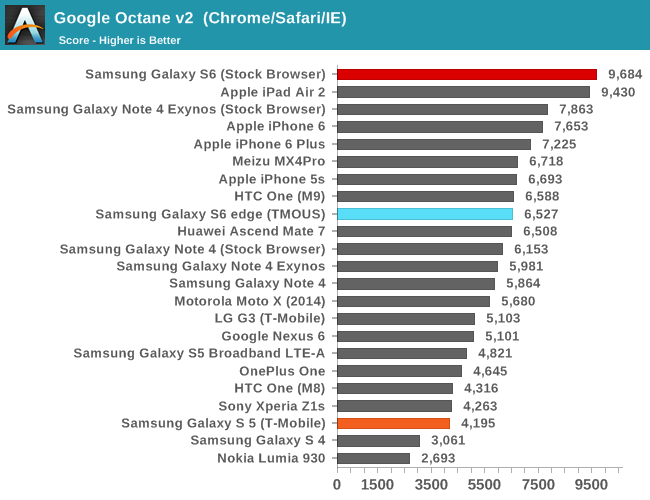

Needless to say, in order to see the full potential of the Exynos 7420 and its cluster of A57s, it’s necessary to use Samsung’s stock browser. This performance is really quite amazing when compared to Apple’s A8X, which has basically been the gold standard for performance in the mobile space in the context of ARM SoCs.
Moving on, as a part of our updates to the benchmark suite for 2015, we'll take a look at Basemark OS II 2.0, which should give a better picture of CPU performance in addition to overall device performance.
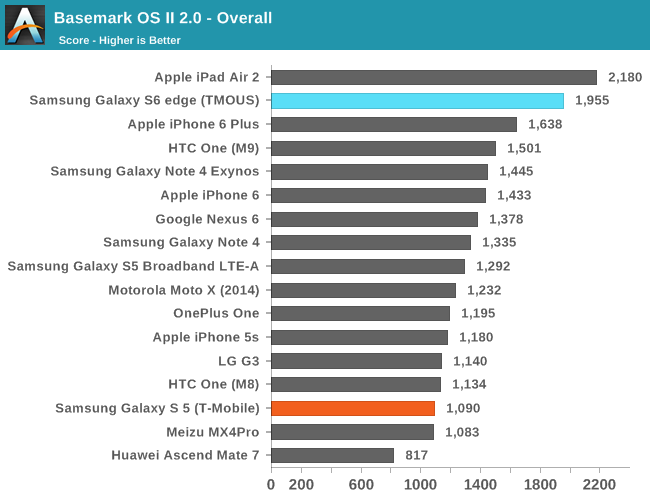
The browser benchmarks seem to hide some pretty enormous variability as the Galaxy S 6 edge (which is comparable to the Galaxy S 6) sets a new record among Android devices. The only challenger is the iPad Air 2, which uses the A8X SoC with three Enhanced Cyclone cores and the semi-custom GXA6850 GPU.
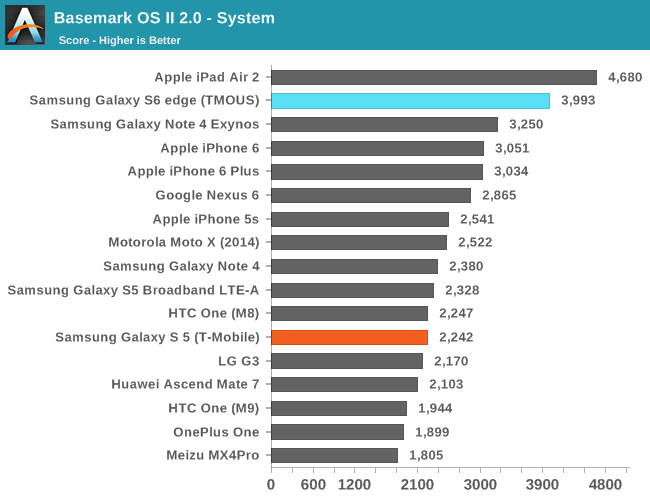
This system test contains a floating point and integer test, in addition XML parsing, which means that this test mostly stresses CPU and RAM. Interestingly enough, the Exynos 7420 pulls far ahead of both the Exynos 5433 and Snapdragon 810 in this test, and approaches the A8X. The difference between the 5433 and 7420 is likely a combination of the higher clocks on both the A57 and A53 clusters for the 7420 (1.9/1.3 on the 5433, 2.1/1.5 on the 7420), in addition to the ability to stay at a high 'overdrive' clock due to reduced leakage from the 14LPE process. The One M9 likely falls a bit short here due to HTC's governor settings restricting the use of all 8 cores simultaneously.

While one might guess that the memory test of 'Basemark OS II 2.0 - Memory' is of RAM, this is actually a test of the internal storage. Once again we see the S6 edge come close to leading the pack due to the use of the new UFS (Universal Flash Storage) standard. Casual examination reveals that the S6 edge has a queue depth of 16, and that it identifies itself with the rather cryptic model name of KLUBG4G1BD-E0B1.
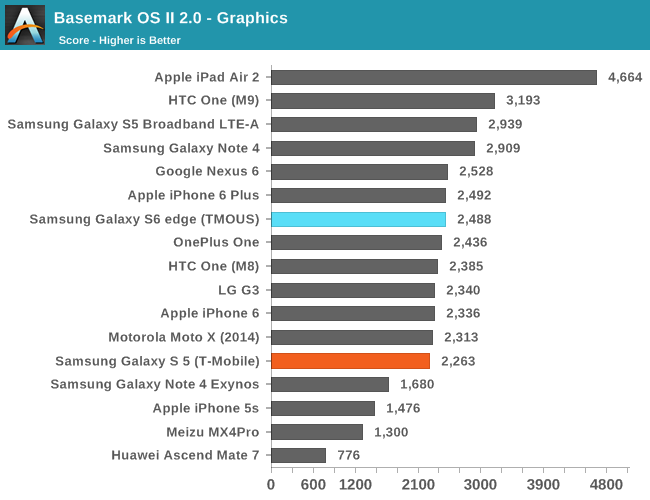
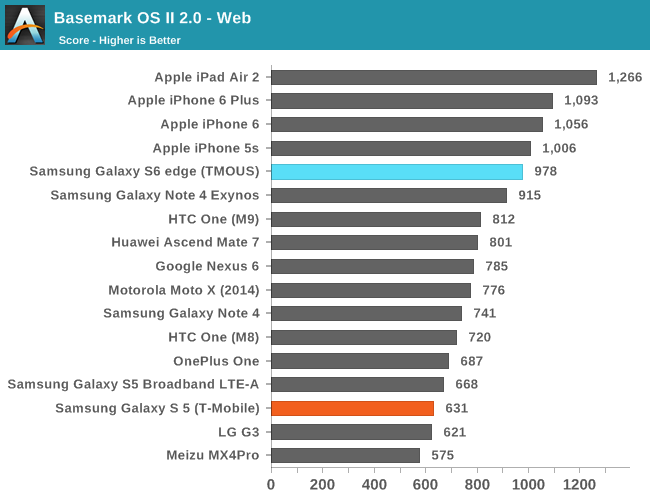
For the web test, it uses the built-in WebView rendering engine rather than Chrome and paints a distinctly different picture, especially because these tests are focused on HTML5 and CSS rather than JavaScript. Here we can see that the iPhone 6 and iPad Air 2 continue to hold their lead, but the Galaxy S6 is pretty much the king of the hill when it comes to Android devices.
Our next system benchmark is PCMark, which does a number of basic benchmarks designed to stress various aspects of the device in everyday workloads like video playback, web browsing, text editing, and photo editing. This tends to test every aspect of a mobile device, unlike microbenchmarks that can often miss aspects of the system that can affect performance.
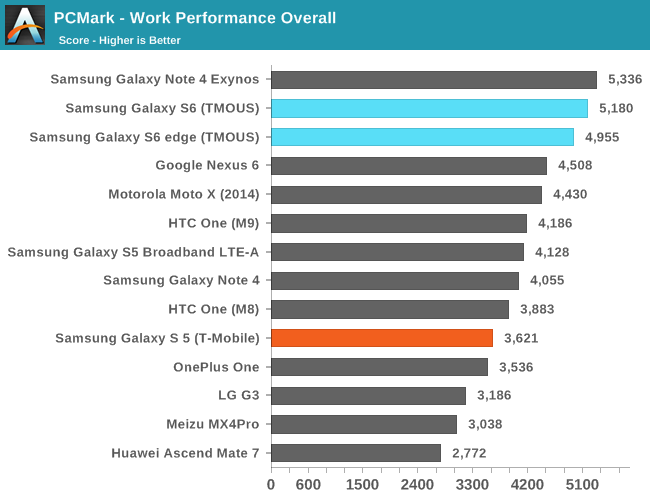
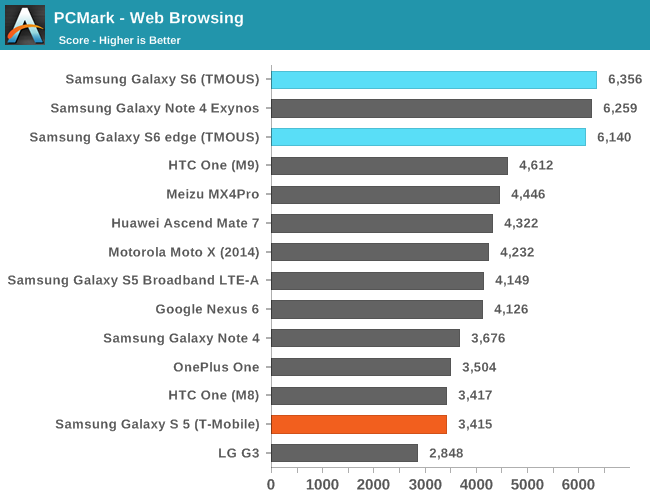
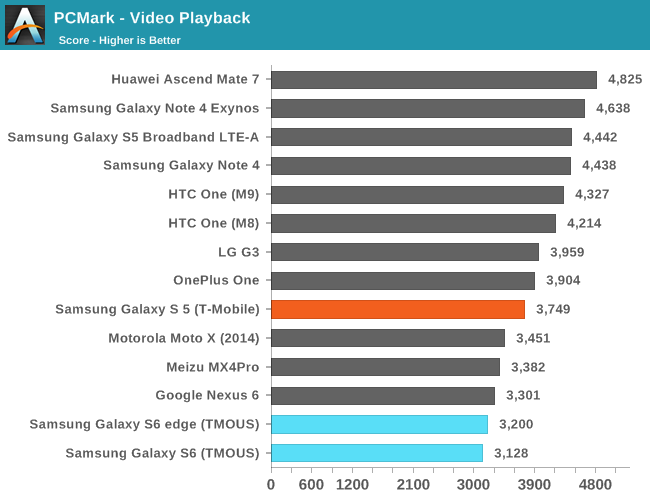
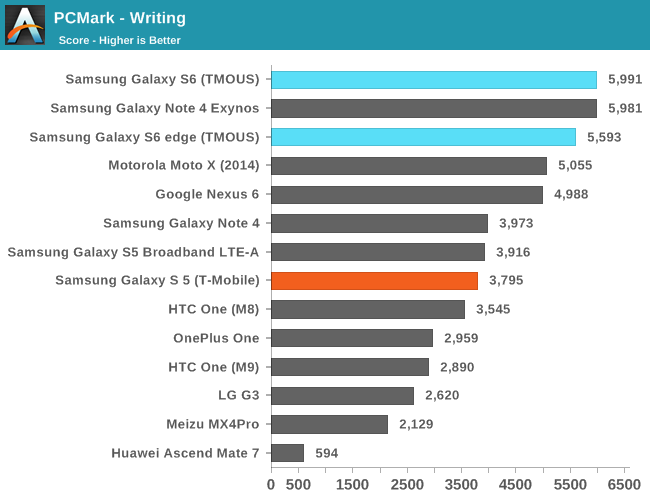

In these tests, the Galaxy S6 continues to perform strongly here due to the fast NAND storage solution and the Exynos 7420 SoC. As we have already covered the Basemark OS II 2.0 results in previous articles, I would refer back to it as those scores are final and have already been contextualized.
Overall, in these general purpose computing tasks that stress CPU, memory, and NAND performance we can see that the Exynos 7420 is off to a flying start. Samsung Mobile should focus more strongly on optimizing the software stack against Chrome as mobile Chrome has around twice the user share of stock Android browsers. I often say that the SoC is the foundation to a good smartphone, and in the case of the Galaxy S6 it feels like this is especially true.










306 Comments
View All Comments
akdj - Sunday, April 26, 2015 - link
I'll re-read, but I could've sworn that was mentioned a couple times. Maybe it was ARS, but I'll check, as you're right. SVoice is the 'front end' to access GVoice and therefore allows Sammy to 'remember' your search information, etc. I've been able to work around, I believe, on my Note 4 now with the 5.0.1 updateUse Google Laincher. Disable Samsung account and sync and mine flies! Much faster than Nova, Go or vanilla TouchWiz and 'possibly' part of Google's Launch code, while using its only syncing data through Google (possibly SVoice or SRememberEverything in the background). I'll have to recheck and time but the update to LP has certainly sped all facets of the UI, updates, app launching and all around perceived 'speed'. I use a dark wallpaper, Nova Launcher 70% of the time and GLauncher the other portion.
Possibly Google's new 5.0.1 code is more specific to usage of its own services overriding those of carrier or the OEM. Again, unsure but damn it flies!
I'm going to spend this week with Google's camera to see if the Note 4 fan shoot the new raw still formats. As a decent camera with Lightroom on board and a CC subscription, I'm excited for the raw output of these hamdsets.
Are you speaking from experience? (Do you own one) or what you've read in reviews? I've certainly seen that mentioned and thought it was here ...pertaining to your suggestion it was forgotten. When I read it, I checked it in the Note 4 and using TW straight, indeed it runs through SVoice first with a significant delay (regardless of bandwidth). It seems quicker in Nova, slower in Go, fastest using Google Launch
pSupaNova - Tuesday, April 21, 2015 - link
Reading this review I can't help thinking Intel is in trouble if Samsung manages to ship lots of this handset.it will show that they are getting their SOC manufacturing into gear.
Schickenipple - Tuesday, April 21, 2015 - link
It's a little comical that a good portion of the 'pluses' of android phones have now gone the way of the iPhone. I fear there will be very little for Samsung lovers to hold over iOS soon.... How will you reboot when the OS freezes every day? Can't add an SD card??!! Blasphemy!Seriously though, they look pretty nice. Almost like an iPhone.
FlushedBubblyJock - Friday, April 24, 2015 - link
oh but if feels so industrial designed and so well built in my hand its so ergonomic my money impression is very, very high as my brain has been fried to a crisp from my desire to be somebody important and wealthy...FlushedBubblyJock - Friday, April 24, 2015 - link
excuse me but i have too go visit steve jobs grave for my monthly pilgrimage, and check my stock portfolio for my apple daily increase, an apple a day keeps retirement at bay !!!holmberg - Wednesday, April 22, 2015 - link
Could we get a measurement of the audio quality (i.e. the DAC and amplifiers, NOT the speakers), similar to what you did for the S5 here:;http://anandtech.com/show/8078/smartphone-audio-te...
FlushedBubblyJock - Friday, April 24, 2015 - link
oHHMMM ah I have recieved a premonition:When the time comes, metal industrial apple clone design won't be the glossy cocktail party rave it is now for all the reviewers... the new "nano carbon" hardshell and totally black design will be the inherently desired feel it up in the hand "win" the reviewers and crybabies all claim we want.
So, soon enough, when it's as cheap as a popcan is now, carbon fiber phone rage will storm the gates.... oh it's so light and so stiff, it feels so strong in my hand (like a fem commenting) ...
YEP - that's coming next - then after the reviewers convince the whole industry to trend toward carbon fiber and leave the metalheads in the dust (their newly created idiots wake) we will have another brain fart of gigantic proportion to deal with...
Warnings about carbon fiber slivers will go unheeded - there may be a whole section on how to reduce scratches and nano crackings and splittings of the fiber along with sales kits and superglue derivatives to rebond the nano cracks...
Next some of the more fervent feeler uppers will wind up in the hospital witth carbon paw poisoning or necessary eye cleansings since they sneezed up the raw carbon tubes into their own faces...
In the mean time they will have alzheimers from feeling up their aluminum metalized wonder industrial builds....
Yep, coming soon to a raw brain fart industry of elite 1% self love.
Forget that plastic if flexible, moldable, much more comfortable in the hand, lighter, and easily snapped apart and together - we must now have metal with apple 5star hex screws - and soon only carbon fiber probably with glass reinforced or ceramic fastener holes... and the elite will rave at the sensational high quality super high $$$$$ feel in their paws...
Yeah man, it's coming - if they charged ten grand for solidified rice paper the elite and feely nerd ego wackos would praise it to the moon and sky...
FlushedBubblyJock - Friday, April 24, 2015 - link
Where the heck is the scree resolution comparison and the pixels per inch chart putting the apple fans to shame ?I just read elsewhere the ppi which was always fanfare here when apple had the lead is 557 ppi ...
That's way above the 200-300+ I'm used to seeing...
So it's 4k resoluion and 557 pixels per inch - doesn't that deserve a whole page of glorious praise comparing to the other losers, which is everyone is it not ?
ubcjack - Tuesday, April 28, 2015 - link
Can Anandtech write an article to explain how Samsung implement PDAF over Sony's IM240 sensor? I'm really interested in the implementation.DIYEyal - Thursday, April 30, 2015 - link
If this phone was thicker with a bigger battery, dual sim, micro SD and waterproof it would have been the perfect phone for me.Rumors suggest that samsung is about to release a dualsim version, so I'll probably buy that.